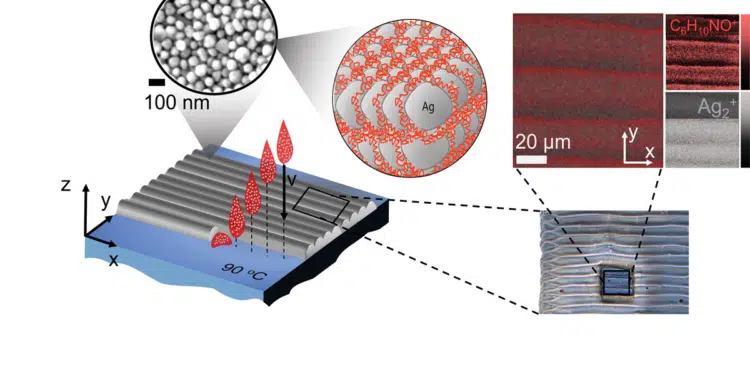Very thin layers of organic stabiliser residue in metal nanoparticle (MNP) inks are behind a loss of conductivity in 3D printed materials and electronic devices, according to the findings of a new study by the University of Nottingham and the National Physical Laboratory.
Inks containing metal nanoparticles are among the most commonly-used conductive materials for printed electronics. Ink-jetting layers of MNP materials allows for unpreceded design flexibility, rapid processing and 3D printing of functional electronic devices such as sensors, solar panels, LED displays, transistors and smart textiles.
Inkjet 3D printing of metals typically form a solid printed object via a two-step process: solvent evaporation upon printing (pinning) and subsequent low-temperature consolidation of nanoparticles (sintering). The low temperature is important as in many applications the nanoparticles are co-printed with other functional/structural organic materials that are sensitive to higher temperatures.
However, layers produced by inkjet printing of metal nanoparticles have different electrical conductivity between horizontal and vertical directions. This effect is known as functional anisotropy and is a long-standing problem for the 3D printing of functional electronic devices, preventing its use for advanced applications.
It was previously thought that reduced vertical conductivity through a printed device is mainly caused by shape and physical continuity problems at the interfaces of the constituent nanoparticles (at the very small micro and nanoscale). However, Nottingham researchers used silver nanoparticles to show, for the first time, that it is caused by organic chemical residues in the inks.
These residues, which are added to the inks to help stabilise the nanomaterials, lead to the formation of low-conducting, very thin nanoscale layers which interfere with the electrical conductivity of the printed sample in the vertical direction.
With a clearer understanding of the distribution of residual organic additives within printed layers, the researchers hope to go on to define new techniques and develop new ink formulations to overcome functional anisotropy of inkjet-based 3D printed electronics.
Lead author, CfAM Research Fellow Dr Gustavo Trindade, said, “The conductivity of inkjet-printed metal nanoparticles is known to be dependent on processing temperature and have been previously attributed to changes in the shape and porosity of clustered nanoparticles, with the role of organic residues being only speculated.”
“This new insight enables the development of routes to overcome functional anisotropy in inkjet-based nanoparticles, and will therefore improve uptake of this potentially transformational technology, making it competitive with conventional manufacturing. Our approach is transferable to other nanomaterial-based inks including those containing graphene and functionalised nanocrystals, and will enable the development and exploitation of both 2D and 3D printed electronics like flexible and wearable sensors, solar panels, LED displays, transistors and smart textiles.” Dr Gustavo Trindade, research fellow at the Centre for Additive Manufacturing































